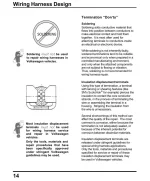crimping vs soldering arguments....
I would think I would have heard every side multiple times by now, and not click, but I cannot help it.
Here's my opinion.
Both have their time and place.
Sometimes one or the other is the better call.
Both can be done correctly, or good enough, or horribly, and there is no shortage of those who have encountered either end and feel ridiculously strongly about their opinions formed from that encounter.
One thing most might not realize, is solder, on a scale of 1 to 100, copper being 100 in terms of conductivity, is only about 15.
So tinning two wires, placeing them side by side then soldering them together, is hardly a low resistance connection, but perhaps the current so low it does not matter.
If twisting two wires together end to end, and two wires side by side, and then soldering them together, is too difficult, I usually crimp.
I dislike insulated connectors, and have bought lots of uninsulated connectors and use 1 or more layers of unequal length adhesive lined heatshrink.
If the wires will vibrate or see potential stress at the end of the crimp, or solder joint, I make sure it cannot flex right there.
Proper crimping can be taken to ridiculous levels, that some might consider just adequate.
Some's 'good enough' would be laughed right out of the cockpit by those with higher standards.
Here's two good articles on the subject:
https://marinehowto.com/marine-wire-termination/
https://marinehowto.com/solder-and-poor-trouble-shooting/
